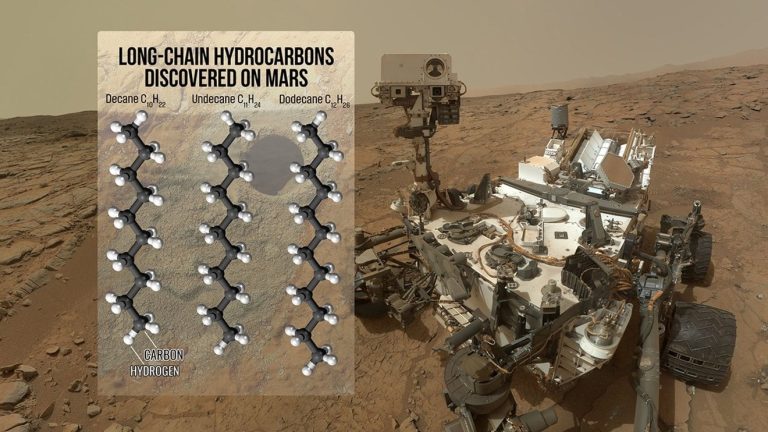Cumberland Findings on Mars: Long-Chain Hydrocarbons Rewrite Planetary Chemistry
The discovery of long-chain hydrocarbons in the Cumberland rock sample from Mars marks a breakthrough in planetary chemistry. It shows that Mars once had conditions capable of preserving organic compounds, offering promising clues about its ancient environment and the potential for life.
Summary:
- Discovery of long-chain hydrocarbons (decane, undecane, and dodecane) in a Mars rock sample
- Evidence suggesting complex organic chemistry that might have led to life
- Indications of an ancient lake environment in Gale Crater
- Analysis performed by NASA’s Curiosity Rover with advanced instruments
- New insights into Mars’ geological and chemical history
- Support for theories about water-mineral interactions on Mars
- Cross-references provided for further scientific details and multimedia resources
Introduction
Recent discoveries on Mars have triggered excitement among scientists. The detection of long-chain hydrocarbons in the Cumberland rock sample, collected by NASA’s Curiosity Rover, provides a fresh perspective on the planet’s past. These natural substances—decane, undecane, and dodecane—give important hints about the involved chemical changes that happened long ago.
Discovery of Organic Molecules
Scientists examined a rock sample extracted from Yellowknife Bay in Gale Crater. Their analysis revealed long-chain hydrocarbons, typically linked with organic matter. These molecules resemble fragments of fatty acids, which are essential components in living organisms. Although they do not directly prove the existence of life on Mars, their presence indicates that the planet once had the right ingredients for life to emerge. The compounds may have resulted from the breakdown of larger molecules during the sample heating process on the rover.
Analysis and Techniques
The sample was processed using the Sample Analysis at Mars (SAM) instrument. This device heated the rock, causing volatile compounds to be released. By measuring the mass of these molecules, scientists identified the organic compounds. The careful techniques employed allowed researchers to reconstruct the chemical environment that once existed on Mars. The results demonstrate that conditions were once favorable for the preservation of complex organic molecules over millions of years.
Environmental Implications
The organic molecules found in the Cumberland sample support the theory that Yellowknife Bay was once home to a lake. A stable, watery environment would have allowed organic compounds to form and be preserved in sedimentary rocks. Interactions between water and minerals can drive the formation of such molecules. This evidence bolsters the idea that Mars was once a dynamic world with the conditions necessary to support life, even if only in its primordial form.
Below is a table summarizing the key organic molecules detected:
| Molecule | Chemical Formula | Importance |
|---|---|---|
| Decane | C10H22 | Indicates the presence of organic matter |
| Undecane | C11H24 | Suggests breakdown of larger fatty acids |
| Dodecane | C12H26 | Linked to life-relevant organic compounds |
Geological Context and Comparative Analysis
Understanding the environment in Gale Crater is crucial. The region’s sedimentary rocks, formed in an ancient lake, have preserved evidence of water and chemical processes. This setting allowed organic molecules to accumulate, much like how ancient lakes on Earth trap and preserve organic matter. The table below compares the geological conditions on Mars with those on Earth in similar settings:
| Aspect | Mars (Gale Crater) | Earth (Ancient Lakes) |
|---|---|---|
| Water Presence | Ancient lake environment | Seasonal and permanent lakes |
| Organic Preservation | Sedimentary rock deposition | Fossilization in lake sediments |
| Chemical Processes | Hydrothermal and mineral interactions | Similar water-induced chemical reactions |
Implications for Future Research
This discovery paves the way for further exploration. With evidence of long-chain hydrocarbons, scientists are now more confident in planning missions to retrieve additional samples. Advanced instruments like SAM are crucial for analyzing the subtle chemical signatures that reveal Mars’ history. Future missions may detect even more complex organic molecules, deepening our understanding of how life could have arisen. The improved analytical techniques promise to refine our knowledge of both Martian geology and its potential for harboring life.
Researchers now face the exciting challenge of linking these chemical clues with the planet’s broader geological history. By comparing data from different regions of Mars, scientists can build a more detailed picture of the ancient environment. These efforts are integral to answering the longstanding question: Did Mars ever support life?

Scientific Significance and Broader Impact
The detection of organic compounds is a landmark moment in planetary science. It connects geological phenomena with the building blocks of life. The findings suggest that Mars once possessed a chemical “soup” that might have led to the emergence of living organisms. This breakthrough not only alters our understanding of Mars but also influences the search for life beyond Earth.
Interdisciplinary collaboration is key in this field. Chemists, geologists, and astrobiologists are working together to interpret the data. Their combined efforts shed light on how organic molecules are preserved in harsh environments. The study reinforces the importance of international cooperation in space exploration, where every new discovery adds a piece to the puzzle of our solar system’s history.
Facts
Mars has fascinated humanity for centuries. Its red color has inspired myths, art, and scientific inquiry. Today, missions to Mars continue to unravel its secrets one sample at a time. The planet’s dynamic past, evidenced by water and preserved organics, captivates both researchers and the public.
Conclusion
The Cumberland rock sample from Mars has rewritten part of our understanding of planetary chemistry. The discovery of long-chain hydrocarbons indicates that Mars once had the conditions necessary to nurture complex organic molecules. While these findings do not confirm past life, they strengthen the argument that Mars could have supported life under the right conditions. Future missions will build on these insights, bringing us closer to solving the mystery of life beyond Earth.
References
For more information, please visit NASA’s Curiosity Rover News, view the research on PNAS, or watch the video on YouTube.

